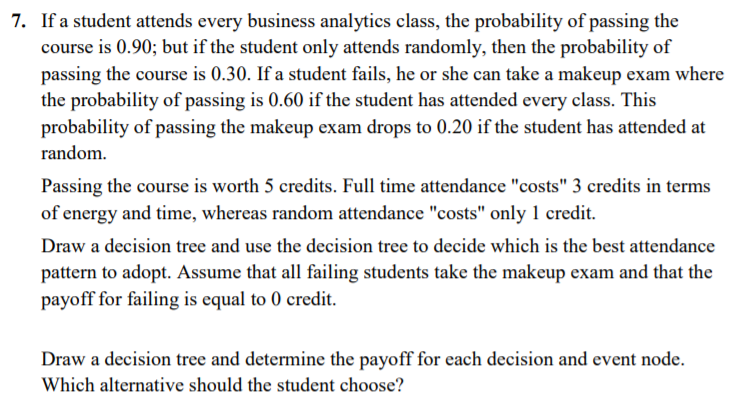If a student attends every business analytics class, the probability of passing the course is 0.90; but if the student only attends randomly, then the probability of passing the course is 0.30. If a student fails, he or she can take a makeup exam where the probability of passing is 0.60 if the student has attended every class. This probability of passing the makeup exam drops to 0.20 if the student has attended at random. Passing the course is worth 5 credits. Full time attendance "costs" 3 credits in terms of energy and time, whereas random attendance "costs" only 1 credit. Draw a decision tree and use the decision tree to decide which is the best attendance pattern to adopt. Assume that all failing students take the makeup exam and that the payoff for failing is equal to 0 credit. Draw a decision tree and determine the payoff for each decision and event node. Which alternative should the student choose?
If a student attends every business analytics class, the probability of passing the course is 0.90; but if the student only attends randomly, then the probability of passing the course is 0.30. If a student fails, he or she can take a makeup exam where the probability of passing is 0.60 if the student has attended every class. This probability of passing the makeup exam drops to 0.20 if the student has attended at random. Passing the course is worth 5 credits. Full time attendance "costs" 3 credits in terms of energy and time, whereas random attendance "costs" only 1 credit. Draw a decision tree and use the decision tree to decide which is the best attendance pattern to adopt. Assume that all failing students take the makeup exam and that the payoff for failing is equal to 0 credit. Draw a decision tree and determine the payoff for each decision and event node. Which alternative should the student choose?
Chapter8: Sequences, Series,and Probability
Section8.7: Probability
Problem 11ECP: A manufacturer has determined that a machine averages one faulty unit for every 500 it produces....
Related questions
Concept explainers
Contingency Table
A contingency table can be defined as the visual representation of the relationship between two or more categorical variables that can be evaluated and registered. It is a categorical version of the scatterplot, which is used to investigate the linear relationship between two variables. A contingency table is indeed a type of frequency distribution table that displays two variables at the same time.
Binomial Distribution
Binomial is an algebraic expression of the sum or the difference of two terms. Before knowing about binomial distribution, we must know about the binomial theorem.
Topic Video
Question
please, please show your work, I will rate your answer!!!!!

Transcribed Image Text:7. If a student attends every business analytics class, the probability of passing the
course is 0.90; but if the student only attends randomly, then the probability of
passing the course is 0.30. If a student fails, he or she can take a makeup exam where
the probability of passing is 0.60 if the student has attended every class. This
probability of passing the makeup exam drops to 0.20 if the student has attended at
random.
Passing the course is worth 5 credits. Full time attendance "costs" 3 credits in terms
of energy and time, whereas random attendance "costs" only 1 credit.
Draw a decision tree and use the decision tree to decide which is the best attendance
pattern to adopt. Assume that all failing students take the makeup exam and that the
payoff for failing is equal to 0 credit.
Draw a decision tree and determine the payoff for each decision and event node.
Which alternative should the student choose?
Expert Solution
This question has been solved!
Explore an expertly crafted, step-by-step solution for a thorough understanding of key concepts.
This is a popular solution!
Trending now
This is a popular solution!
Step by step
Solved in 3 steps with 1 images

Knowledge Booster
Learn more about
Need a deep-dive on the concept behind this application? Look no further. Learn more about this topic, probability and related others by exploring similar questions and additional content below.Recommended textbooks for you

